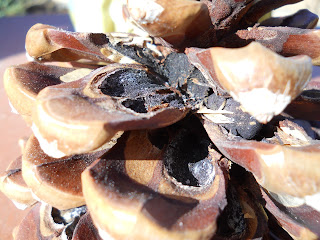Since fall is the time of the harvest, what better way to do a nature journal entry than to do a search for different "fruits" in the wild.
After you've gone on your hunt and found seed containers of all kinds (pine cones aren't officially a fruit but they sure do contain seeds), have fun drawing their outsides, pulling them apart and drawing the seeds and comparing all the different ways seeds can be protected as well as the different colors and shapes of the seeds.
For your beginners they can practice their shapes by sorting their fruits into fruits with circles, rounded triangles, rectangles and ovals (and whatever other shapes you might find). Then, they draw the shapes and color in the shapes to match the color of the fruit or seed container they are trying to depict.
Botanically speaking, fruits are the swollen ovary that provides an additional covering over the seeds. This would include things like, tomatoes, squash, cucumbers, seed pods, rose hips AND the things we typically think of as fruits such as apples and pears.
After you've gone on your hunt and found seed containers of all kinds (pine cones aren't officially a fruit but they sure do contain seeds), have fun drawing their outsides, pulling them apart and drawing the seeds and comparing all the different ways seeds can be protected as well as the different colors and shapes of the seeds.
Art and Observation:
The really cool thing about this one is that for older kids they can practice their drawing skills by sketching the seed container from different angles BEFORE opening it up and the also sketching the seeds and interior of the fruit. |
| This Poster botanical print is from zazzle.com. Alice's are not nearly this sophisticated (nor mine), but I have known highschoolers capable of this kind of work. |
For your beginners they can practice their shapes by sorting their fruits into fruits with circles, rounded triangles, rectangles and ovals (and whatever other shapes you might find). Then, they draw the shapes and color in the shapes to match the color of the fruit or seed container they are trying to depict.




No comments:
Post a Comment
Thanks for your comments!